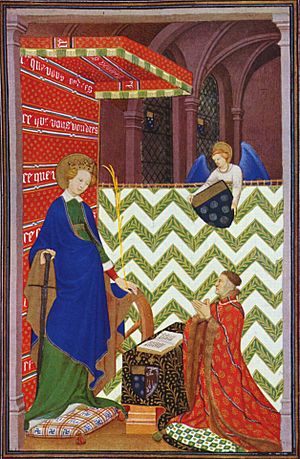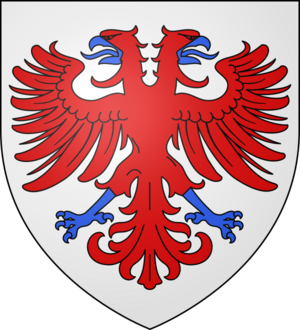Jean II Le Maingre facts for kids

Quick facts for kids
Jean II Le Maingre
|
|
|---|---|
| Born | 28 August 1366 |
| Died | 21 June 1421 (aged 54) |
Jean II Le Maingre (pronounced ZHAN luh MAN-gruh), also known as Boucicaut (Boo-see-KOH), was a famous French knight and military leader. He was born on August 28, 1366, and lived until June 21, 1421. Boucicaut was known for his great military skills. He also represented the ideals of chivalry, which meant being brave, honorable, and loyal. Because of his bravery and leadership, he was given the important title of marshal of France.
Contents
A Life of Chivalry
Early Years and Training
Boucicaut was the son of another famous knight, Jean I Le Maingre. His father was also called Boucicaut and was a Marshal of France. Jean II started his training very young. At just 12 years old, he became a page at the court of Charles V of France. This meant he served the king and learned about court life.
When he was 12, he joined Louis II, Duke of Bourbon, in a military campaign. This was against Normandy, a region in France. At 16, he was knighted by Duke Louis. This happened just before the Battle of Roosebeke in 1382. From 1383, Boucicaut began many journeys. These travels would take up more than 20 years of his life.
Journeys and Crusades
In 1384, Boucicaut made his first trip to Prussia. He went to help the Teutonic Order. This was a group of knights fighting against the pagan Lithuanians. The Lithuanians later converted to Roman Catholicism in 1386. After this, Boucicaut fought against the Moors in Spain. He also fought against Toulouse in France.
He then joined the Duke of Bourbon again. This time, they went to Spain. Spain had become a battlefield during the Hundred Years' War. From Spain, Boucicaut traveled for two years. He explored the Balkans, the Near East, and the Holy Land. He was with his friend Renaud of Roye and later with Philip of Artois, Count of Eu. During these travels, they wrote a book of poems. It was called Livre des Cent Ballades. This book defended the idea of a pure and honorable knight.
In 1390, the war with England paused. Boucicaut and two other French knights organized a tournament called Saint-Inglevert. Here, he competed against strong English knights. He managed to unhorse three of his 18 opponents. The next year, he traveled to Prussia for a third time. Because of his great service in wars against non-Christians, he was named Marshal of France. This important title was given to him on December 25, 1391, by King Charles VI.
In 1396, Boucicaut joined a large crusade. This was a joint French and Hungarian effort against the Ottoman Empire. However, the crusaders suffered a big defeat. This happened at the Battle of Nicopolis on September 28. Boucicaut was captured by the Ottoman sultan, Bayezid I. Many of his companions were executed, but Boucicaut survived. He was eventually set free after a ransom was paid.
In 1399, he started a new group of knights. It was called the Emprise de l'Escu vert à la Dame Blanche. This group was inspired by the idea of courtly love. This meant knights would show great respect and devotion to a noble lady. In the same year, he was sent to help the Byzantine emperor Manuel II Palaeologus. The Ottomans were attacking Constantinople. Boucicaut arrived with six ships and 1,200 men.
Governor of Genoa
In 1401, Boucicaut was given a new role. He became the French governor of Genoa, a powerful Italian city. Genoa had come under French rule in 1396. He used his military skills and knowledge of the East in this role. He successfully defended Genoa from an attack by King Janus of Cyprus. The king tried to take back the city of Famagusta on Cyprus. This city had been captured by Genoa.
Boucicaut later tried to attack Alexandria. But bad winds stopped him. He then went to Tripoli. After a difficult attempt to capture it, he moved south to Botron. This city was burned and looted. He then went to Beirut on August 10, 1403. Beirut was also attacked, and valuable spices were taken. He continued to attack Sidon and Latakia. Both cities had strong defenses. He returned to Famagusta in late August. He then settled in Rhodes in September. From there, he sent 500 men to try and take Alexandria again, but they were unsuccessful.
On his way back, he was defeated by the Venetians. This happened at the Battle of Modon on October 7, 1403. After some more conflicts in the Mediterranean Sea, the people of Genoa gained their freedom from French rule by 1409.
Final Years
Boucicaut returned to France. He became involved in the rivalry between the Burgundy and Orléans families. These powerful families were fighting for control. In 1415, he fought in the famous Battle of Agincourt. He commanded the French vanguard, which was the front part of the army. However, he was captured by the English during the battle.
Jean II Le Maingre, Boucicaut, died six years later in Yorkshire, England, in 1421. He was buried in the Collégiale Saint-Martin in Tours, France. This is now the Basilica of St. Martin, Tours. He was laid to rest in his family's chapel. His tombstone had an epitaph. It called him "Grand Constable of the Emperor and of the Empire of Constantinople."


